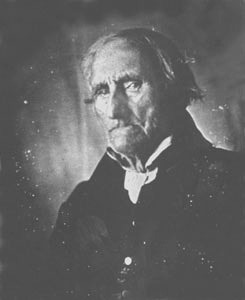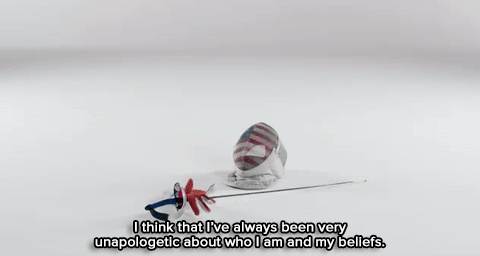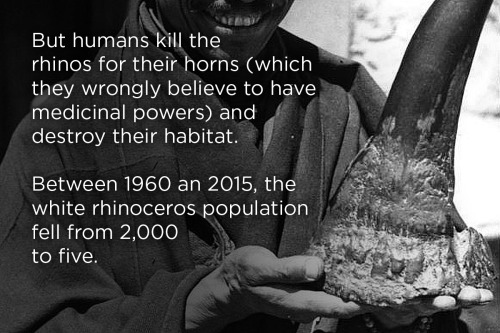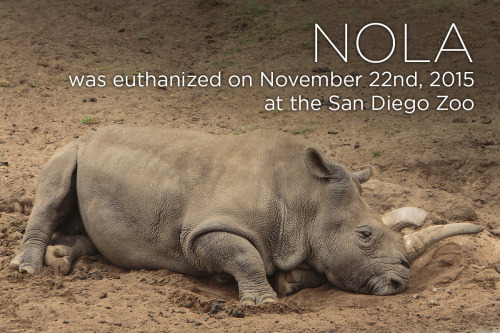Penelope.

Penelope.
More Posts from Defpuma and Others


Amazingly, we have a photograph of a man who crossed the Delaware with George Washington. This is Conrad Heyer, born in 1749 and photographed in 1852 at age 103. He served in the Continental Army during the Revolutionary War, crossed the Delaware with Washington in December 1776, and fought in several major battles. The Maine Historical Society says that this makes him the earliest-born human being ever to be photographed.










Watch: Ibtihaj Muhammad is such an inspiration
follow @the-movemnt for more about race, representation and justice






Nola was born in the southern savanna woodlands of Sudan. In the mid-1970s she was captured to protect her from poachers, and in 1989 she moved to the San Diego Zoo. She shared her enclosure with buffalo, giraffes and gazelles, and enjoyed daily belly scratches.
In 1990, a male rhinoceros named Angalifu joined Nola in San Diego, but she wasn’t interested in him. After hormone treatments, she mated with another male named Saut, but never became pregnant.
Saut died in 2004. Angalifu died last year. Nola was getting older, and suffering from a bacterial infection. Yesterday the zoo announced:
In the last 24 hours, Nola’s condition worsened and we made the difficult decision to euthanize her. We’re absolutely devastated by this loss, but resolved to fight even harder to #EndExtinction.
With the death of Nola this weekend, the northern white rhinoceros inches closer to true extinction. But it became extinct in the wild 2008, and the remaining rhinos have all been to old to breed for several of years. Still, there are plans to resurrect the subspecies using a preserved egg and sperm. The San Diego Zoo’s Institute has pledged $2 million to this difficult project.
And there is reason to be hopeful. A cousin subspecies, the southern white rhino, has seen its population blossom from 20 to 20,000 in the last century thanks to the intervention of humans.
Want to learn more? Check out this article by my friend (and housemate) Sarah Kaplan.
Image credits: Jeff Keaton, Make it Kenya, Ernst Schäfer, Colin P. Groves et al, TONY KARUMBA/AFP/Getty Images
Unpopular opinion: Allosaurus is way cooler than T. Rex.
Team Allosaurus 2k15
Ball is life.

American paleontologist O.C. Marsh with assistants. c. 1872.

Meet a Mount: Peabody Museum Stegosaurus


Taxon: Stegosaurus ungulatus
Specimen Number: PMNH 1853 and PMNH 1858
Year Created: 1910
Stegosaurus was a strange looking animal, but with its long, tottering legs and minuscule head, the Peabody Museum of Natural History Stegosaurus ungulatus mount is stranger still. This mount, constructed by Hugh Gibb and W.S. Benton under the supervision of curator Richard Lull, owes its bizarre proportions to the fact that it is a chimeric combination of at least five differently-sized individuals.
O.C. Marsh named Stegosaurus ungulatus in 1877 based on fossils found at Como Bluff, Wyoming, and illustrated it with eight tail spikes. Although modern researchers have since rejected this reconstruction, the mount at Marsh’s home institution still sports the extra-spikey tail. In another way, however, this Stegosaurus mount was ahead of its time. Lull insisted that the tail was held aloft, rather than dragging on the ground, to better function as a defensive weapon.
-
 wander-over-the-words reblogged this · 7 years ago
wander-over-the-words reblogged this · 7 years ago -
 jailor reblogged this · 8 years ago
jailor reblogged this · 8 years ago -
 placeholderworld liked this · 8 years ago
placeholderworld liked this · 8 years ago -
 defpuma reblogged this · 8 years ago
defpuma reblogged this · 8 years ago -
 tooinfinite reblogged this · 8 years ago
tooinfinite reblogged this · 8 years ago -
 pawsitively reblogged this · 8 years ago
pawsitively reblogged this · 8 years ago -
 genderstuffedoreos reblogged this · 8 years ago
genderstuffedoreos reblogged this · 8 years ago -
 kirudono reblogged this · 8 years ago
kirudono reblogged this · 8 years ago -
 sry7tuiyhy liked this · 8 years ago
sry7tuiyhy liked this · 8 years ago -
 apathetic-nerd reblogged this · 8 years ago
apathetic-nerd reblogged this · 8 years ago -
 milesperhour699 reblogged this · 8 years ago
milesperhour699 reblogged this · 8 years ago -
 maiagarroway-archive reblogged this · 8 years ago
maiagarroway-archive reblogged this · 8 years ago -
 haikuforcats liked this · 8 years ago
haikuforcats liked this · 8 years ago -
 rhondafreeman liked this · 8 years ago
rhondafreeman liked this · 8 years ago -
 space-grl02 liked this · 8 years ago
space-grl02 liked this · 8 years ago -
 beadpig liked this · 8 years ago
beadpig liked this · 8 years ago -
 writerlyintentorsomething reblogged this · 8 years ago
writerlyintentorsomething reblogged this · 8 years ago -
 shrimpet reblogged this · 8 years ago
shrimpet reblogged this · 8 years ago -
 defpuma liked this · 8 years ago
defpuma liked this · 8 years ago -
 rosiekitty reblogged this · 8 years ago
rosiekitty reblogged this · 8 years ago -
 treinmeisje liked this · 8 years ago
treinmeisje liked this · 8 years ago -
 ozzyonedge reblogged this · 8 years ago
ozzyonedge reblogged this · 8 years ago -
 ozzyonedge liked this · 8 years ago
ozzyonedge liked this · 8 years ago -
 nanwarner liked this · 8 years ago
nanwarner liked this · 8 years ago -
 septum-rings liked this · 8 years ago
septum-rings liked this · 8 years ago -
 despisal liked this · 8 years ago
despisal liked this · 8 years ago -
 leannfernald liked this · 8 years ago
leannfernald liked this · 8 years ago -
 tui2--start liked this · 8 years ago
tui2--start liked this · 8 years ago -
 tumamaesmaracaaa liked this · 8 years ago
tumamaesmaracaaa liked this · 8 years ago -
 gregorjosephfritsch liked this · 8 years ago
gregorjosephfritsch liked this · 8 years ago -
 lickleraincloud liked this · 8 years ago
lickleraincloud liked this · 8 years ago -
 3nch4nt3d-sn41l reblogged this · 8 years ago
3nch4nt3d-sn41l reblogged this · 8 years ago -
 fmartp liked this · 8 years ago
fmartp liked this · 8 years ago -
 admiraldoge reblogged this · 8 years ago
admiraldoge reblogged this · 8 years ago -
 lilytwinkle liked this · 8 years ago
lilytwinkle liked this · 8 years ago
